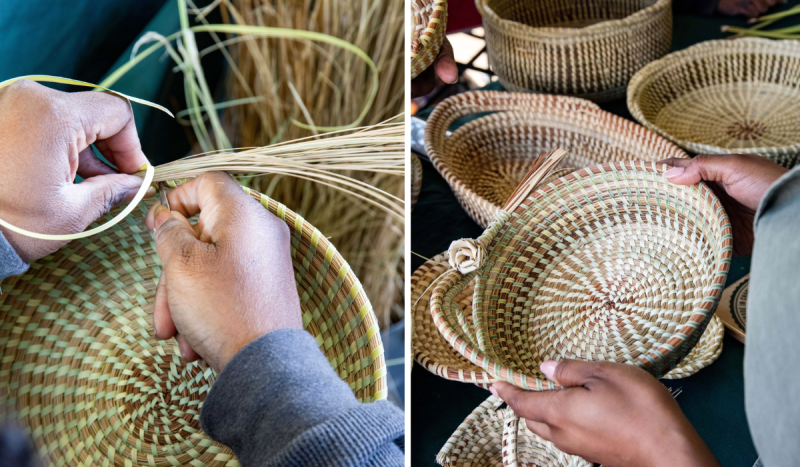It’s known as the Holy City, with a renowned culinary scene, and beautiful historic streets teeming with Southern charm. Of the many sides of Charleston that make it so appealing, the role of its African American citizens and African forbears is paramount. Rather than shying away from its history, the city openly addresses its past and celebrates all that African people brought to the area and their impact and influence today.
Opening this summer, the new International African American Museum, situated at the former site of one of the biggest slave trading ports in the country, shines a light on all facets of Black life here, from the early days of slave ships and the continued struggles during the civil rights era to the resiliency of its people and the cultural wonders of today. There’s so much to dig into on a trip to Charleston—here’s a visual primer to get you started.
Get to know the Gullah experience

Gullah artisans’ hand-woven sweetgrass
Peter Frank Edwards
The Gullah Geechee people, an African American community with deep ties to their African origins, live along the Sea Islands surrounding coastal South Carolina (and throughout the East Coast, extending from North Carolina to Florida). Their influence on Lowcountry culture and cuisine is vast to this day—savor it in restaurants and see it firsthand in artisan offerings around town.

Find hand-woven sweetgrass baskets at Charleston City Market
The artistry of hand-woven sweetgrass baskets is a skill that’s been passed down for generations for over 300 years. You’ll find excellent examples at Charleston City Market, where more than 50 Gullah artisans are in residence.

Gillie’s Seafood
This lauded foodie city packs a punch of flavor from Black chefs cooking in restaurants inspired by the Gullah tradition. Sample some Lowcountry classics like shrimp and grits, or Catfish Charleston at Gillie’s Seafood, helmed by chef Sean Mendes, who provides Southern comfort foods inspired by his own granny’s cooking.

Hannibal’s Soul Kitchen
Another must-hit spot is Hannibal’s Soul Kitchen, a Charleston mainstay since 1985, offering items informed by the Gullah Geechee, from okra soup to crab and shrimp rice dishes.
A wealth of enriching historic sites to explore
You’ll find important landmarks of the Black experience all throughout Charleston. Start at the International African American Museum for a deep dive into the full history; explore the Old Slave Mart Museum, the site of the last slave auction facility in South Carolina, built in 1859; and take in mass or just pay a visit to Mother Emanuel AME Church, the oldest African Methodist Episcopal church in the Southern United States, founded in 1817. For time in the outdoors, you can’t beat an afternoon at the Magnolia Plantation and Gardens.

Magnolia Plantation and Gardens
The Magnolia Plantation and Gardens has the distinction of being deemed “America’s Most Beautiful Gardens” and one of the oldest plantations in the South, listed on the National Register of Historic Places. It’s the earliest tourist destination in the Lowcountry and the oldest public gardens in America, having opened its doors to the public in 1870. Be sure to book the “From Slavery to Freedom: The Magnolia Cabin Project Tour” in advance, to get a fuller picture of the role of enslaved people in the Lowcountry and on this plantation specifically.

International African American Museum
Explore nine galleries and a genealogy center—where guests can research their family history—all spread out over more than 150,000 square feet at the International African American Museum. The museum “strives to foster empathy and understanding, empowering visitors with the knowledge of the past”—you couldn’t ask for a more compelling mission statement.
Partake in cultural outings

Philip Simmons Garden
Take time to visit sites and tours that will immerse you in the Black Charleston experience today. At the Philip Simmons Garden, tribute is paid to the poetic ironworks of the namesake Master Blacksmith, whose apprentices continue on in his legacy to this day. Gullah Tours, led by Alphonso Brown—a native of Charleston’s rural community, Rantowles, who’s fluent in Gullah language and well-versed in Gullah customs—will bring you to such fascinating destinations as Catfish Row, the inspirational setting for Gershwin’s Porgy & Bess.

Examples of sweetgrass artistry, of which Mary Jackson is an internationally recognized master.
At the Mary Jackson Modern and Contemporary Gallery at the Gibbes Museum of Art you’ll find works made over the past 40 years by artists who are native to the area or whose works reflect the complex story of the Lowcountry area. Many pieces address the legacy of slavery in America and the landscape of the South.

Corene, 1995, by Jonathan Green, at left.











